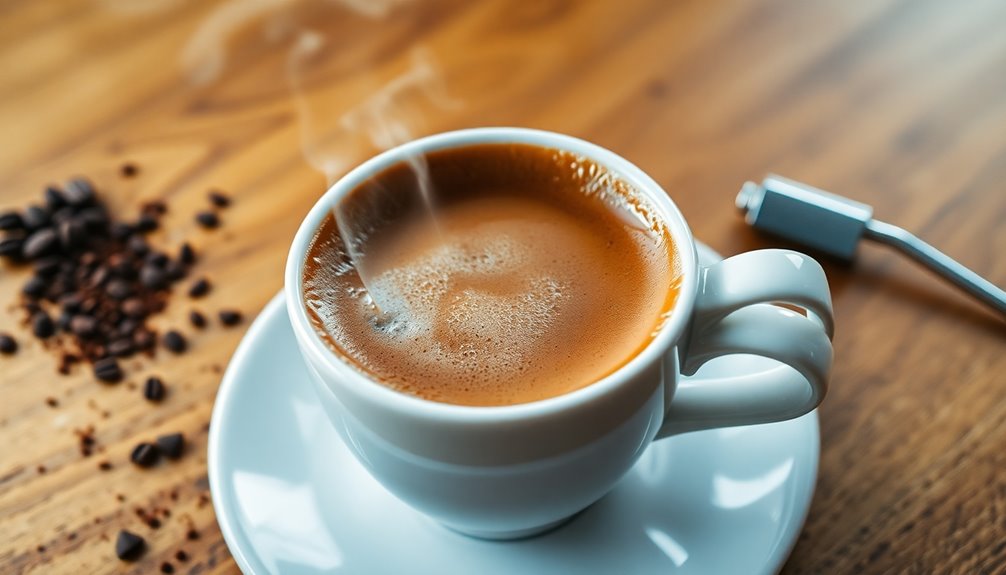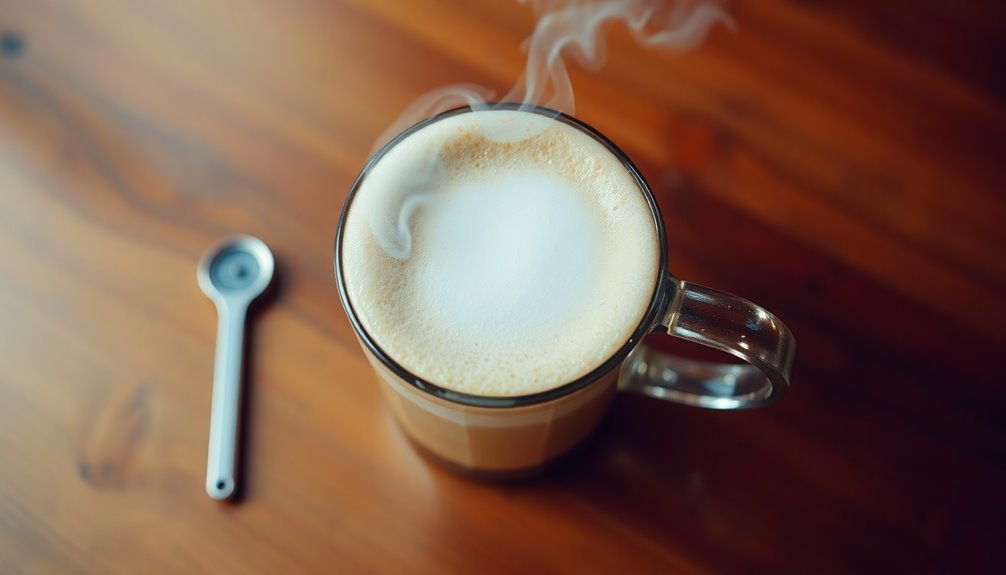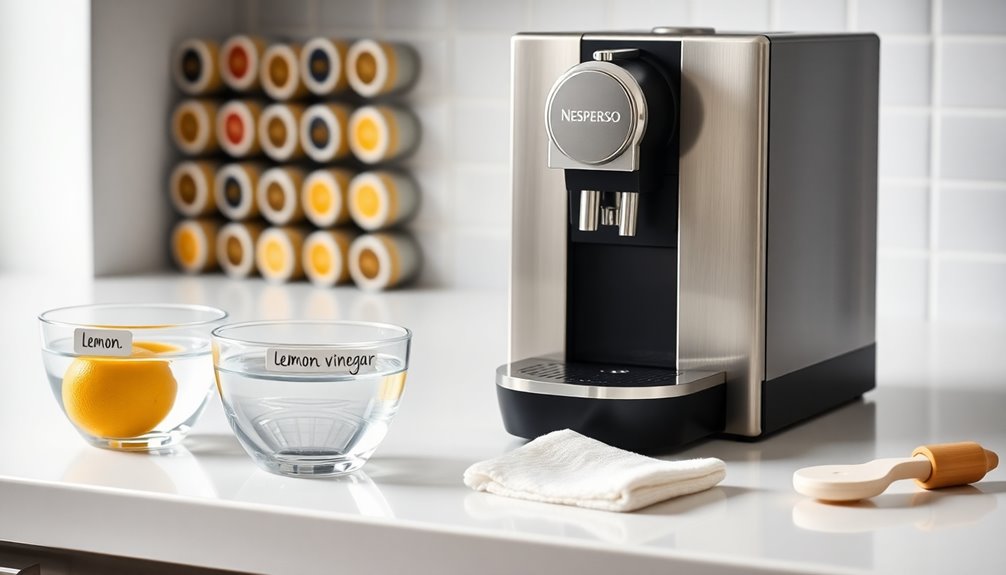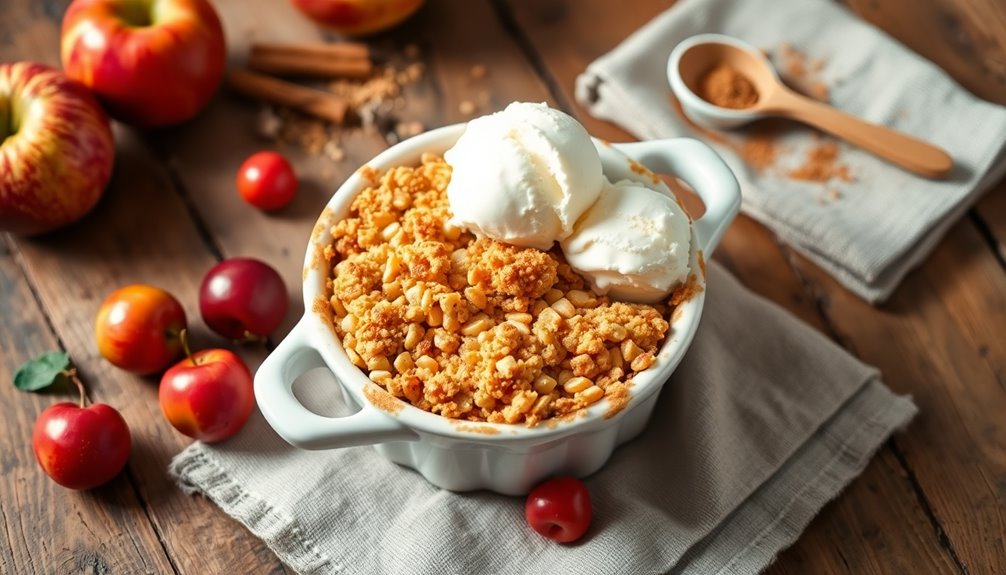To make the perfect cappuccino, heat your milk to a temperature between 55 to 65°C (131 to 149°F). This range helps preserve the milk's natural sweetness and creates a creamy, velvety texture without burning. If you go over 70°C, you'll risk a bitter taste and a poor foam structure. To achieve ideal frothing, aim for around 60°C and guarantee your milk has small, fine bubbles. This enhances the overall sipping experience by making the cappuccino enjoyable and smooth. Curious to learn more about perfecting your cappuccino technique? There's plenty ahead to explore!
Key Takeaways
- The ideal milk temperature for cappuccino is between 55 to 65°C (131 to 149°F) for optimal flavor and texture.
- Heating milk within the ideal range enhances sweetness and prevents a burnt taste in the cappuccino.
- Frothing milk at approximately 60°C creates a creamy texture and stable foam for a better drinking experience.
- Using a thermometer helps ensure precise temperature control, improving the overall quality of the cappuccino.
- Properly prepared cappuccinos at the right temperature enhance flavors and provide a smooth mouthfeel without scalding.
Ideal Temperature Range

When making a cappuccino, hitting the ideal temperature range for the milk is key. You want to keep it between 55 to 65°C (131 to 149°F). This range guarantees your milk remains creamy and sweet, avoiding that burnt taste that comes from overheating. It helps create a velvety texture, enhancing the overall mouthfeel of your drink. Precise temperature control is essential for retaining the proteins and fats in the milk, which contributes to stable foam formation. This balance between foam and flavor greatly impacts your cappuccino's enjoyment. To monitor the temperature accurately, invest in a coffee milk thermometer or a contactless digital thermometer, guaranteeing consistent results every time. Additionally, understanding coffee temperature preferences can significantly elevate your brewing skills.
Effects of Temperature on Milk

Heating milk to the right temperature greatly influences its composition, flavor, and texture.
When you heat milk between 55-65°C, it denatures proteins, allowing them to trap air bubbles effectively, which enhances foam stability. This ideal temperature preserves the milk's natural sweetness, creating a more enjoyable flavor profile. Consistency in milk temperature is essential for achieving the perfect cappuccino, as it directly affects the overall taste.
If you overheat milk, typically above 70°C, you risk breaking down the proteins, leading to a bitter taste and an unpleasant burnt flavor. This can also disrupt the foam's structure, resulting in large, unstable air bubbles.
Maintaining the correct temperature not only enhances the overall taste of your cappuccino but also guarantees a smooth texture, making your coffee experience far more pleasurable.
Milk Frothing and Texture

Perfectly frothed milk can elevate your cappuccino experience, building on the importance of temperature in milk preparation. Aim to froth your milk between 55 to 65 degrees Celsius (131 to 149 degrees Fahrenheit), with around 60 °C being ideal.
Start incorporating air into the milk as soon as possible; it absorbs air better when colder. Position the steam wand just below the surface to achieve that creamy texture. For cappuccino froth, continue adding air a bit longer than for lattes.
Adjust the wand to make the milk roll, breaking up larger bubbles for uniformity. Once you hit the desired temperature, shut off the steam, wipe the wand, and tap the pitcher to smooth out bubbles before pouring. The steamed milk plays a crucial role in achieving the rich flavor and creamy texture that cappuccinos are known for.
Impact on Drinking Experience

Although many factors contribute to a great cappuccino, the temperature of the milk plays an essential role in shaping your drinking experience.
Keeping the milk between 55-65°C (131-149°F) guarantees a velvety texture and stable foam, enhancing your enjoyment. This ideal range avoids burnt flavors that can ruin the taste and smell, preserving the milk's subtle sweetness. Properly frothed milk, made from whole milk, creates a rich and creamy experience that complements the espresso base.
You'll find it comfortable to sip, as it won't scorch your mouth. If the milk's too cold, the froth becomes thin, while overheating makes it watery and disrupts the flavor.
A well-prepared cappuccino with properly heated milk not only meets your expectations but also delivers a harmonious blend of flavors and textures, making each sip a pleasure. The rich, velvety foam creates a luxurious mouthfeel, elevating the entire coffee experience. To further enhance your cappuccino enjoyment, consider the perfect cappuccino cup selection tips, which emphasize the importance of size and shape for optimal heat retention and aesthetic appeal. Ultimately, the right cup can make all the difference, allowing you to savor every drop of this delightful beverage.
Barista Techniques and Equipment

To create that ideal cappuccino experience, mastering barista techniques and utilizing the right equipment is key.
Heat your milk to a precise 55 to 65°C (131 to 149°F) for the best results. If you go too low, you'll end up with unstable milk, and too high can ruin flavor and texture. Proper refrigeration of milk is crucial; it should be below 40°F to maintain its frothing capacity.
Invest in a digital quick-read thermometer to monitor milk temperature accurately. Remember to stop steaming about 10 degrees shy of your target, as the milk will continue to warm.
Use a good milk frothing pitcher—choose stainless steel or calibrated designs for better control.
Refrigerate your milk below 40°F to enhance frothing, and aim for small, fine bubbles for that creamy texture that defines a great cappuccino.
General Guidelines and Variations

When crafting a cappuccino, understanding general guidelines and variations is essential for achieving the desired flavor and texture. Aim to keep your milk between 60-70°C (140-150°F) for ideal results. Proper heating is crucial as optimal milk temperature enhances flavor and foam stability.
For a classic cappuccino, target 60-65°C to balance the espresso, steamed milk, and foam. If you're making a latte, go for 65-70°C to accommodate more steamed milk. A flat white benefits from the same temperature as a cappuccino, while a macchiato should be around 60°C for a smooth blend.
Tips for Perfect Cappuccino Temperature

Getting the temperature right for your cappuccino is key to bringing out the best flavor and texture. Aim for a milk temperature between 55°C and 65°C.
Use a calibrated thermometer to measure accurately, and turn off the steam just before reaching your target to prevent overheating. You can also judge by touch; if the jug's too hot to hold for more than two seconds, it's likely too hot.
Avoid scalding the milk, as that ruins its taste. Reheating milk disrupts its proteins, making it unpalatable. Maintaining the optimal temperature range preserves milk's natural flavors is crucial for achieving the best taste in your cappuccino.
Practice your pouring technique for a consistent balance, and maintain a clean environment to guarantee accurate readings.
With these tips, you'll achieve the perfect cappuccino every time!
Frequently Asked Questions
Can I Use Almond Milk for Cappuccinos?
Absolutely, you can use almond milk for cappuccinos!
It froths well, creating a thick, stable foam that adds a creamy, nutty flavor to your drink. Just brew your espresso, froth the almond milk, and pour it in.
You might enjoy experimenting with sweetened or unsweetened varieties. Plus, it's lower in calories and perfect for those who are lactose intolerant or vegan.
Go ahead and enjoy your almond milk cappuccino!
How Can I Tell if Milk Is Overheated?
You can tell if milk is overheated by checking its temperature and texture. If it exceeds 65°C (149°F), it's too hot.
Look for a watery consistency and unstable froth; it shouldn't be lumpy. Pay attention to any burnt or sulphurous smells, as these indicate overheating.
Visually, if the milk appears brownish or discolored, and the foam is thin, it's definitely overheated, compromising the quality of your drink.
What Type of Thermometer Is Best for Milk?
When it comes to choosing the best thermometer for milk, you'll want to take into account efficiency and hygiene.
Contactless digital thermometers are perfect for quick, accurate readings without touching the milk, ensuring sanitation.
Traditional probes can be cumbersome and less hygienic, while manual judgment by touch is often unreliable.
For consistent results, opt for a well-calibrated contactless thermometer to help you achieve the ideal milk temperature every time you prepare your drinks.
Does Milk Fat Content Affect Frothing Temperature?
Yes, milk fat content definitely affects frothing temperature.
If you're using whole milk, the higher fat content helps create a rich, stable foam when heated within the ideal range.
However, reduced-fat milk may not froth as well since it has less fat, leading to instability in your foam.
Keep in mind, heating non-dairy milk above 55°C can also compromise its texture and flavor, so temperature control is key for great frothing results.
Can I Reheat Cappuccino Milk if It's Too Cold?
Yes, you can reheat cappuccino milk if it's too cold, but do it carefully.
Microwaving works, but keep an eye on the temperature to avoid overheating, which can ruin the flavor and texture.
It's best to serve your cappuccino immediately after preparation to prevent it from getting cold.
Using insulated cups can help maintain warmth longer, so consider that for future drinks.
Just remember, reheating can impact the overall taste.
Conclusion
To craft the perfect cappuccino, aim for that sweet spot between 150°F and 155°F. This temperature not only enhances the flavor but also allows the milk to froth beautifully, creating that creamy texture you crave. Remember, a cappuccino's enjoyment hinges on balance, so don't let it get too hot. With a few simple tips and the right techniques, you'll be sipping on a delightful cup every time. Happy brewing!










